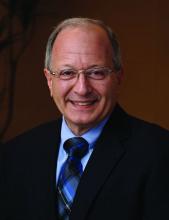PHILADELPHIA – Eosinophilic esophagitis (EoE) responsive to a proton pump inhibitor (PPI) has been characterized as PPI-responsive esophageal eosinophilia (PPI-REE), but there is no compelling evidence that it is a distinct EoE subgroup, according to an expert who updated current thinking about this disease at Digestive Diseases: New Advances.
“Multivariate analyses have not identified any feature that distinguishes PPI-REE from EoE. Why? Because they are probably the same disorder,” reported Stuart J. Spechler, MD, AGAF, codirector of the center for esophageal diseases at Baylor University Medical Center at Dallas.
The substantial response in EoE patients to PPI therapy, which is nearly 50% in some studies, has been a source of confusion. PPIs reduce gastric acid, but EoE is not an acid-related disease, according to Dr. Spechler. The picture is now becoming clearer with new evidence that PPIs do more. Dr. Spechler reviewed evidence that PPIs inhibit inflammatory cells, exert antioxidant properties, and decrease the inflammatory cytokine signaling that drives eosinophil activation and adhesion.Although it is true that only a subset of EoE patients respond to PPIs, few therapies are effective for all patients in any disease Dr. Spechler observed. As an example, he noted that ulcerative colitis patients who respond to sulfasalazine are not subclassified as sulfasalazine-responsive ulcerative colitis.
“I do think the term PPI-REE should be retired, although I acknowledge that not everyone in this field is ready to agree,” Dr. Spechler said at the meeting, held by Rutgers, the State University of New Jersey, and Global Academy for Medical Education. Global Academy and this news organization are owned by the same company.
The confusion regarding PPI responsiveness in EoE has been driven by the fact that acid control has been widely regarded as the only pertinent mechanism of action from PPIs. Although coexisting gastroesophageal reflux disease could explain symptom relief in some patients with EoE, no evidence of excess acid is found in many responders. Detailed evaluations of the PPI-REE subgroup relative to EOE overall emphasize this point, according to Dr. Spechler.
“Studies have shown that the clinical, endoscopic, histologic, and gene expression features of these two disorders are identical,” he reported.
The lack of distinction is now easier to understand with a growing body of evidence that PPIs have acid-independent effects relevant to benefit in EoE, according to Dr. Spechler. Tracing the advances in understanding the pathogenesis in EoE since it was first described in 1978, Dr. Spechler explained that EoE is now understood to be an antigen-driven expression of food allergy related to up-regulation of the Th2 helper adaptive response. After briefly reviewing several potential anti-inflammatory effects of PPIs, Dr. Spechler focused on evidence that PPIs inhibit the adhesion molecule eotaxin-3.
Specifically, when squamous cells from EoE patients are exposed to the cytokine interleukin-4 (IL-4), “production of eotaxin-3 is increased dramatically but you can block that cytokine Th2 stimulation with [the PPI] omeprazole,” said Dr. Spechler, citing published work by Edaire Cheng, MD, a researcher with whom he has collaborated at the University of Texas Southwestern Medical School, Dallas. This is a potentially important observation, because up-regulation of eotaxin-3 is considered a critical molecular event for the activation of eosinophils and their migration.
The relative importance of this specific mechanism for explaining the benefits of PPIs in EoE requires additional confirmation, but Dr. Spechler indicated that there is strong evidence of acid-independent effects from PPIs. In fact, in outlining an algorithm for treatment of EoE, he listed a trial of PPIs as a reasonable first choice.
“In my opinion, the major reason that we created an arbitrary distinction is this persistent notion that acid inhibition is the only possible therapeutic effect of PPIs,” Dr. Spechler reported. “I hope I have convinced you otherwise.”
In his brief update of EoE treatment in 2017, Dr. Spechler identified a trial of PPIs as first line “simply because they work.” However PPIs have been rendered even more attractive by the evidence of a plausible mechanism of action in EoE. Conversely, he cautioned that steroids are “just a band-aid” because “they cover up the allergy but the allergy remains.” Ultimately, while PPIs are a reasonable first-line therapy to control symptoms, Dr. Spechler suggested that elimination diets are ultimately the best strategy for treating the underlying cause of EoE.
Dr. Spechler reported a financial relationship with Ironwood Pharmaceuticals.


